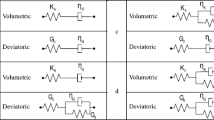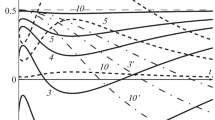Abstract
Poisson’s ratio in viscoelastic solids is in general a time dependent (in the time domain) or a complex frequency dependent quantity (in the frequency domain). We show that the viscoelastic Poisson’s ratio has a different time dependence depending on the test modality chosen; interrelations are developed between Poisson’s ratios in creep and relaxation. The difference, for a moderate degree of viscoelasticity, is minor. Correspondence principles are derived for the Poisson’s ratio in transient and dynamic contexts. The viscoelastic Poisson’s ratio need not increase with time, and it need not be monotonic with time. Examples are given of material microstructures which give rise to designed time dependent Poisson’s ratios.
Similar content being viewed by others
References
Pipkin, A.C.: Lectures on Viscoelasticity Theory. Springer, Berlin Heidelberg New York (1972)
Adams, R.D., Peppiatt, N.A.: Effect of Poisson’s ratio strains in adherends on stresses of an idealized lap joint. J. Strain Anal. 8, 134–139 (1973)
Ferry, J.D.: Viscoelastic Properties of Polymers, 2nd edn. Wiley, New York (1970)
Lakes, R.S.: Viscoelastic Solids. CRC, Boca Raton, Florida (1998)
Hilton, H.H.: Implications and constraints of time-independent Poisson’s ratios in linear isotropic and anisotropic viscoelasticity. J. Elast. 63, 221–251 (2001)
Tschoegl, N.W., Knauss, W., Emri, I.: Poisson’s ratio in linear viscoelasticity – A critical review. Mech. Time-Depend. Mater. 6, 3–51 (2002)
Lu, H., Zhang, X., Knauss, W.G.: Uniaxial, shear, and Poisson relaxation and their conversion to bulk relaxation. Polym. Compos. 18, 211–222 (1997)
Kugler, H., Stacer, R., Steimle, C.: Direct measurement of Poisson’s ratio in elastomers. Rubber Chem. Technol. 63, 473–487 (1990)
Sokolnikoff, I.S.: Mathematical Theory of Elasticity. Krieger, Malabar, Florida (1983)
Read Jr., W.T.: Stress analysis for compressible viscoelastic materials. J. Appl. Phys. 21, 671–674 (1950)
Gross, B.: Mathematical Structure of the Theories of Viscoelasticity. Hermann, Paris (1968)
Timoshenko, S.P., Goodier, J.N.: Theory of Elasticity. McGraw-Hill, London (1982)
Chen, C.P., Lakes, R.S.: Holographic study of conventional and negative Poisson’s ratio metallic foams: Elasticity, yield, and micro-deformation. J. Mater. Sci. 26, 5397–5402 (1991)
Gurtin, M.E., Sternberg, E.: On the linear theory of viscoelasticity. Arch. Ration. Mech. Anal. 11, 291–356 (1962)
Anderson, D.L.: Theory of the Earth. Blackwell, Boston, Massachusetts (1989)
Gibson, L.J., Ashby, M.F.: Cellular Solids, 2nd edn. Cambridge University Press, Cambridge, UK (1997)
Weiner, J.H.: Statistical Mechanics of Elasticity. Wiley, New York (1983)
Kolpakov, A.G.: On the determination of the averaged moduli of elastic gridworks. Prikl. Mat. Meh. 59, 969–977 (1985)
Lakes, R.S.: Advances in negative Poisson’s ratio materials. Adv. Mater. (Weinheim, Germany) 5, 293–296 (1993)
Lakes, R.S.: Foam structures with a negative Poisson’s ratio. Science 235, 1038–1040 (1987)
Lakes, R.S.: The time dependent Poisson’s ratio of viscoelastic cellular materials can increase or decrease. Cell. Polym. 11, 466–469 (1992)
Biot, M.A.: General theory of three-dimensional consolidation. J. Appl. Phys. 12, 155–164 (1941)
Zener, C.: Internal friction in solids. I. Theory of internal friction in reeds. Phys. Rev. 52, 230–235 (1937)
Nye, J.F.: Physical Properties of Crystals. Oxford University Press, London, UK (1976)
Zener, C., Otis, W., Nuckolls, R.: Internal friction in solids. III. Experimental demonstration of thermoelastic internal friction. Phys. Rev. 53, 100–101 (1938)
Christensen, R.M.: Restrictions upon viscoelastic relaxation functions and complex moduli. Trans. Soc. Rheol. 16, 603–614 (1972)
Author information
Authors and Affiliations
Corresponding author
Rights and permissions
About this article
Cite this article
Lakes, R.S., Wineman, A. On Poisson’s Ratio in Linearly Viscoelastic Solids. J Elasticity 85, 45–63 (2006). https://doi.org/10.1007/s10659-006-9070-4
Received:
Accepted:
Published:
Issue Date:
DOI: https://doi.org/10.1007/s10659-006-9070-4




